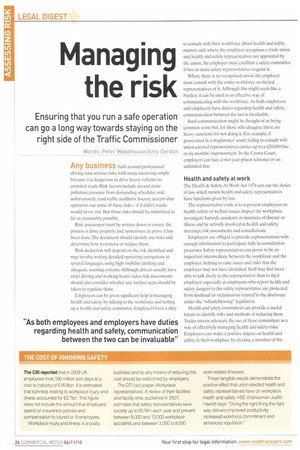Managin the risk
Page 26

Page 27

If you've noticed an error in this article please click here to report it so we can fix it.
Ensuring that you run a safe operation can go a tong way towards staying on the right side of the Traffic Commissioner
Words: Peter Woodhouse/Amy Gordon
Any business built around professional driving runs serious risks, with many occurring simply because it is dangerous to drive heavy vehicles on crowded roads. Risk factors include air and noise pollution, pressure from demanding schedules and, unfortunately, road traffic accidents. Society accepts that operators run some of these risks — if it didn't, trucks would never run. But those risks should be minimised as far as reasonably possible.
Risk assessment must he written down to ensure the process is done properly and, sometimes, to prove it has been done. The document should identify any risks and determine how to remove or reduce them.
Risk deduction will depend on the risk identified and may involve writing detailed operating instructions in several languages, using high-visibility clothing and adequate warning systems Although drivers usually have strict driving and working hours' rules, risk assessments should also consider whether any further steps should be taken to regulate those.
Employers can be given significant help in managing health and safety by talking to the workforce and setting up a health and safety committee. Employers have a duty to consult with their workforce about health and safety matters and, where the employer recognises a trade union and health and safety representatives are appointed by the union, the employer must establish a safety committee if two or more safety representatives request it.
Where there is no recognised union, the employer must consult with the entire w-orkforee or elected representatives of it. Although this might seem like a burden, it can be used as an effective way of communicating with the workforce. As both employees and employers have duties regarding health and safety, communication between the two is invaluable.
Such communication might be thought of as being common sense but, for those who disagree, there are heavy sanctions for not doing it, For example, if prosecuted in a magistrates' court, failing to consult with union-elected representatives carries up to a £20,000 fine or six months' imprisonment. In the Crown Court, employers can face a two-year prison sentence or an unlimited fine.
Health and safety at work
The Health & Safety At Work Act 1974 sets out the duties in law, which means health and safety representatives have functions given by law.
The representative's role is to represent employees on health, safety or welfare issues, inspect the workplace, investigate hazards, accidents or instances of disease or illness and be actively involved in health and safety meetings, risk assessments and consultations.
Employers are obliged to provide representatives with enough information to participate fully in consultation processes. Safety representatives can prove to be an important intermediary between the workforce and the employer, helping to raise issues and risks that the employer may not have identified. Staff may feel more able to talk freely to the representative than to their employer, especially as employees who report health and safety dangers to the safety representative are protected from dismissal or victimisation related to the disclosure under the "whistleblowing" legislation.
Health and safety committees can provide a useful forum to identify risks and methods of reducing them. Trades unions advocate the use of these committees as a way of effectively managing health and safety risks. Employers can make a positive impact on health and safety in their workplace by electing a member of the management team to champion health and safety matters and regularly arrange committee meetings.
Transport firms have duties to the Traffic Commissioner (TC), who in many cases focus on road safety Operators who use feedback from health and safety committees to, for example, adjust long or difficult routes, are less likely to breach drivers' hours rules, and consequently less likely to fall out with the TC.
Working relationships
Close working relationships between the owner and the employees is common in small businesses, often leading to good communication about health and safety issues. Management of small businesses may work alongside employees, giving them an insight into the likelihood of risks. Such businesses dominate sectors with the highest rates of fatal and non-fatal injuries such as transport. agriculture and construction. This means that health and safety is of concern to the smallest business.
To feel the positive effect of safety representatives in the workplace, employer effort is required. Employers must fully engage with representatives and the health and safety committee and ensure they receive relevant training. This investment of time can be cost-effective. Significant savings can he made if businesses reduce workplace-related sickness absence and claims for compensation in respect of workplace illness and injury. Health and safety committees are not another talking shop. They can, and should be, used as a valuable forum for discussing and reducing workplace risks to the benefit of the individual, the operator, and society as a whole. in
• Peter Woodhouse and Amy Gordon work at specialist transport solicitors Stone King LIP, Bath. Email: petermiudima,,,




































































































































